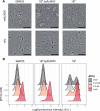Ribosome Provisioning Activates a Bistable Switch Coupled to Fast Exit from Stationary Phase
- PMID: 30835283
- PMCID: PMC6501884
- DOI: 10.1093/molbev/msz041
Ribosome Provisioning Activates a Bistable Switch Coupled to Fast Exit from Stationary Phase
Abstract
Observations of bacteria at the single-cell level have revealed many instances of phenotypic heterogeneity within otherwise clonal populations, but the selective causes, molecular bases, and broader ecological relevance remain poorly understood. In an earlier experiment in which the bacterium Pseudomonas fluorescens SBW25 was propagated under a selective regime that mimicked the host immune response, a genotype evolved that stochastically switched between capsulation states. The genetic cause was a mutation in carB that decreased the pyrimidine pool (and growth rate), lowering the activation threshold of a preexisting but hitherto unrecognized phenotypic switch. Genetic components surrounding bifurcation of UTP flux toward DNA/RNA or UDP-glucose (a precursor of colanic acid forming the capsules) were implicated as key components. Extending these molecular analyses-and based on a combination of genetics, transcriptomics, biochemistry, and mathematical modeling-we show that pyrimidine limitation triggers an increase in ribosome biosynthesis and that switching is caused by competition between ribosomes and CsrA/RsmA proteins for the mRNA transcript of a positively autoregulated activator of colanic acid biosynthesis. We additionally show that in the ancestral bacterium the switch is part of a program that determines stochastic entry into a semiquiescent capsulated state, ensures that such cells are provisioned with excess ribosomes, and enables provisioned cells to exit rapidly from stationary phase under permissive conditions.
Keywords: experimental evolution; genetics; microbiology; phenotypic heterogeneity.
© The Author(s) 2019. Published by Oxford University Press on behalf of the Society for Molecular Biology and Evolution.
Figures







Similar articles
-
Bistability in a metabolic network underpins the de novo evolution of colony switching in Pseudomonas fluorescens.PLoS Biol. 2015 Mar 12;13(3):e1002109. doi: 10.1371/journal.pbio.1002109. eCollection 2015 Mar. PLoS Biol. 2015. PMID: 25763575 Free PMC article.
-
Repeated Phenotypic Evolution by Different Genetic Routes in Pseudomonas fluorescens SBW25.Mol Biol Evol. 2019 May 1;36(5):1071-1085. doi: 10.1093/molbev/msz040. Mol Biol Evol. 2019. PMID: 30835268 Free PMC article.
-
Global GacA-steered control of cyanide and exoprotease production in Pseudomonas fluorescens involves specific ribosome binding sites.Proc Natl Acad Sci U S A. 1999 Nov 23;96(24):14073-8. doi: 10.1073/pnas.96.24.14073. Proc Natl Acad Sci U S A. 1999. PMID: 10570200 Free PMC article.
-
rRNA transcription and growth rate-dependent regulation of ribosome synthesis in Escherichia coli.Annu Rev Microbiol. 1996;50:645-77. doi: 10.1146/annurev.micro.50.1.645. Annu Rev Microbiol. 1996. PMID: 8905094 Review.
-
Ribosome Hibernation.Annu Rev Genet. 2018 Nov 23;52:321-348. doi: 10.1146/annurev-genet-120215-035130. Annu Rev Genet. 2018. PMID: 30476446 Review.
Cited by
-
Reduced ATP-dependent proteolysis of functional proteins during nutrient limitation speeds the return of microbes to a growth state.Sci Signal. 2021 Jan 26;14(667):eabc4235. doi: 10.1126/scisignal.abc4235. Sci Signal. 2021. PMID: 33500334 Free PMC article.
-
Polar accumulation of pyoverdin and exit from stationary phase.Microlife. 2024 Feb 14;5:uqae001. doi: 10.1093/femsml/uqae001. eCollection 2024. Microlife. 2024. PMID: 38370141 Free PMC article.
-
Modeling single-cell phenotypes links yeast stress acclimation to transcriptional repression and pre-stress cellular states.Elife. 2022 Nov 9;11:e82017. doi: 10.7554/eLife.82017. Elife. 2022. PMID: 36350693 Free PMC article.
-
Ecological scaffolding and the evolution of individuality.Nat Ecol Evol. 2020 Mar;4(3):426-436. doi: 10.1038/s41559-019-1086-9. Epub 2020 Feb 10. Nat Ecol Evol. 2020. PMID: 32042121
-
Physiological stress drives the emergence of a Salmonella subpopulation through ribosomal RNA regulation.Curr Biol. 2023 Nov 20;33(22):4880-4892.e14. doi: 10.1016/j.cub.2023.09.064. Epub 2023 Oct 24. Curr Biol. 2023. PMID: 37879333 Free PMC article.
References
-
- Ackermann M. 2015. A functional perspective on phenotypic heterogeneity in microorganisms. Nat Rev Microbiol. 13(8): 497–508. - PubMed
-
- Balaban NQ, Merrin J, Chait R, Kowalik L, Leibler S.. 2004. Bacterial persistence as a phenotypic switch. Science 305(5690): 1622–1625. - PubMed
-
- Bao Y, Lies DP, Fu H, Roberts GP.. 1991. An improved Tn7-based system for the single-copy insertion of cloned genes into chromosomes of gram-negative bacteria. Gene 109(1): 167–168. - PubMed
-
- Beaumont HJE, Gallie J, Kost C, Ferguson GC, Rainey PB.. 2009. Experimental evolution of bet hedging. Nature 462(7269): 90–93. - PubMed
Publication types
MeSH terms
Substances
LinkOut - more resources
Full Text Sources

